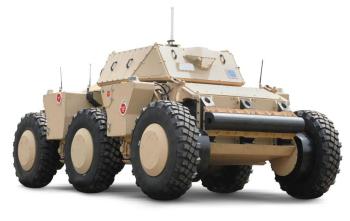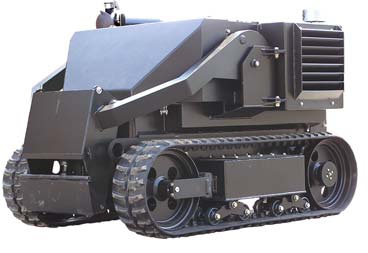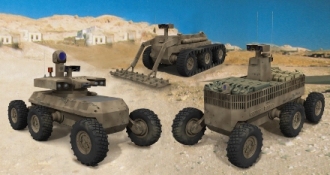Military transportation robots
Logistics have always been an important part of successful warfare. Military transportation robots can increase the efficiency of logistics as well as aid soldiers in movement.There are a lot of things to move both on the battlefield as well as in its vicinity. Indeed, weapons, ammunition and different supplies have to be moved to the point of action. At the end – causalities also have to be picked up from the battlefield.
By putting humans to this work they are often exposed to a risk that could be avoided. I’m not talking only about people that carry things around in a backpack – more about the drivers that have to drive into dangerous areas.
Sure, that is what they do for living. Still, these hazards could be avoided and the transportation jobs made more effective. This is where military transportation robots come into the story.
You can imagine how the robots could ease causality extraction from the battlefield. Also, different transportation jobs could be made more effective. At the end, soldiers could travel longer distances if they could take more supplies with them.
Autonomous Platform Demonstrator

The Autonomous Platform Demonstrator or APD is a military transportation robot developed by the U.S. Army Tank Automotive Research, Development and Engineering center – TARDEC. It’s a 9.6-ton heavy and 15-foot long UGV designed to demonstrate latest technological achievements in this field.
It has a hybrid-electric drive train with six in-hub electric motors powered by li-ion batteries charged using an on-board diesel generator. The APD is a skid steer vehicle that can pivot-turn in place. Other technologies include a lightweight hull, an advanced suspension system, and others.
From control point of view it can be controlled in real-time by a soldier or it can operate autonomously. Autonomously it can operate at speeds up to 50 mph. It can travel along a GPS way point route and avoid obstacles in its way.
The robotic vehicle can overcome 1-meter high obstacles and navigate 60 degree steep slopes. The culmination of this program is Soldier Operation Experiments in 2010. Eventually it will become the main test platform for the RVCA (Robot Vehicle Control Architecture) Army Technology Objective.
R-gator

People who like coffee and milk mix them together because one good thing can’t spoil another good thing. The same happens when two companies that are great professionals in their corresponding fields work together to create something new.
This has happened in case of r-gator, one of military transportation robots. John Deere has great experience in making all-terrain vehicles and iRobot has great experience in making robotic solutions. So, they take a battle proven vehicle – the m-gator, equip it with iRobot’s devices and voila – we have an unmanned ground vehicle.
So, it can be remote controlled using an xbox 360 controller (I am not joking). It can move autonomously along a preprogrammed route using GPS. And it can still be driven by a driver. The switching between these modes can be done as easily as switching a switch.
As you can understand, it can be used for numerous purposes. It can be used to remotely inspect areas of interest. It can autonomously patrol and send a video stream back to the command center. It can be used to ensure safe extraction of causalities and to transport cargo. This is not limited of course.
It comes with an Operator control unit. That is basically a computer and an xbox controller. Optionally, a wearable operator control unit is also available. The bottom line is – if you can play xbox you can operate this military transportation robot.
iRobot Warrior

Let’s continue with iRobot’s products. What, you thought that they make only roombas? No, they are actually really into this military stuff and I’ll have to say much more about them in further articles on military robots.
So, the iRobot warrior is actually a multipurpose military robot that can be equipped with different tools, thus making it capable of different tasks. It can carry payloads around 70 kg (150 pounds). This enables it to be used for extraction of causalities, transportation of hazardous materials and others.
Its main advantage is agility. Because of its rather unique design, it can overcome stairs and slopes up to 45 degrees, gaps up to 61 cm and vertical obstacles up to 47 cm. Not all military transportation robots are able to do such things. It is intended to be used on rough terrain as well as in urban environments.
It can be remote controlled or preprogrammed to move along a GPS route. Of course, it has a capability to avoid obstacles as well. It is also equipped with a so called intelligent payload positioning system. So, the chances are it will get to its destination no matter what.
ACER

ACER stands for Armored Combat Engineer Robot. It is made by Mesa robotics. This is a real heavy-weight robot – it weighs about 2 tons and can carry a payload of about 1 ton. On top of that, its arm can lift more than 400 kilograms.
It is not limited to logistics of course. Although, it can be counted as one of military transportation robots, it can do other tasks as well – such as landmine disposal, route clearance and others. One of its main advantages is the ease of maintenance. Maintenance can be done using standard tools.
SMSS

Squad Mission Support System – an all-terrain unmanned ground vehicle. Just as r-gator. it can be remote controlled using a controller, it can be driven by a human and it can work autonomously.
The main idea of this vehicle is to lighten the burden of soldiers. It is done, literally, by taking part of the load off them. SMSS can carry around half a ton of payload, that is, approximately, the weight of a 10 soldier squad’s load.
It can avoid obstacles and clear a given route on its own. The interesting thing is that this UGV was also made in cooperation of two companies – Land Tamer which has great experience in making all-terrain amphibians and Lockheed Martin which has a long history of military R&D.;
You may be interested to look at this video
at Discovery channel. It features the SMSS.
MULE

MULE stands for Multifunction Utility/Logistics and Equipment vehicle. This one is also developed by Lockheed Martin. It is intended to have a few variations. This time I’ll tell you about the transport variation of MULE.
The transport variation of mule can carry equipment and supplies of two infantry squads. It can be modified to allow it to carry almost all possible cargos, including causalities.
The main advantage of this system is its unique suspension and propulsion. Every wheel is driven separately, thus ensuring great off-road capability. Oh, and it is diesel-electric. You may want to check out this YouTube video to see its suspension system in action.
BigDog

This topic about military tranportation robots can’t be closed without telling you something about this robot. The BigDog is developed by Boston Dynamics. All of their robots are quite unique. Usually, the amazing stuff is their movement capabilities.
BigDog is not an exception. All other military transportation robots I told you about were either wheeled robots or treaded. This one is legged so it, literally, walks. And this walking capability is quite astonishing. It can keep its balance even when kicked from the side.
The idea is quite similar to the rest of the robots mentioned on this page – it is intended to carry supplies for soldiers in order to help them in their missions. The main advantage, of course, is its legs. Because of its walking capabilities, it can go where most wheeled and treaded robots are helpless.
Hydraulics are used to move its legs and a diesel motor is used to drive the hydraulic pump.
I am not aware if any of the above mentioned military transportation robots is being used at the moment, but, as far as I know, this is not very far from reality.SMSS should be fully developed and given to the military this year, MULE is scheduled to 2011 and others are also pretty close to the actual application.
Well this is it! I hope you found this collection of information interesting.
Go back from “Military transportation robots” to “Military robots”.
